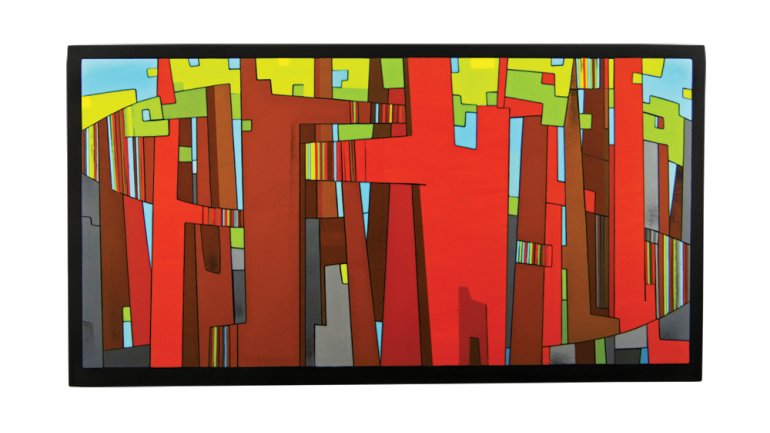Travelogue
Travelogue
Why do some places from our past evoke strong emotions while others blur together? When we reflect on a city, is it the architecture we remember most, or the feelings we had while we were there? Morgan Madison is the first to admit that he’s not sure, but he’s trying to find out. His sculpture is his research.
“I’m out exploring, trying to figure out what it is about these places and particular objects or scenes that really draw me in,” the 38-year-old says. The Seattle artist pours his experiences into works made of glass, cardboard, and more, but always leaves room for the viewer, striving to “paint the outlines of a picture and then let people fill in the details, with their own experience as a guide.”
The kiln-cast, cold-worked Refactory (2014), for instance, calls to mind an industrial scene in almost any city, but to call it generic would belie its distinct character, memorable for its layered red tones, rough edges, and looming smokestack. His glass wall panels, too, vividly communicate the spirit of a place while refusing to be cluttered by unnecessary detail – a private journal with broad appeal.
“These ideas and this work grow from these real, literal looks at what’s around, and then I’m distilling that, trying to get an essence of these places or these elements that are interesting,” he says. “I don’t know exactly why certain things stand out and others don’t, but there’s something universal about that.”
Madison’s path to glass began in 2000 with a job on the hot end – near the furnaces – of Bullseye Glass Co., the influential glass manufacturer in Portland, Oregon. He’d just graduated with a BA in studio art from Lewis and Clark College the year before.
“It was just a crash course in material,” Madison recalls; at Bullseye, he was casting sheets of glass and blowing frac (fracture glass). “I didn’t have any interest in glass before I started working there, at all. It just wasn’t on my radar. I couldn’t help but take home scraps from the factory and fool around with them.”
Glass quickly became his main medium. In the decade and a half since Bullseye, Madison has participated in numerous workshops throughout the Pacific Northwest and in places as far-flung as Australia. His professional residencies have included North Lands Creative Glass in Scotland and the Pilchuck Glass School in Washington.
Last summer, he spent four months in residence at New York City’s Museum of Arts and Design. As part of the program, MAD invites museum visitors to watch the resident artists working and ask them questions. The foot traffic, Madison reflects, forced him to refine his thinking so he could articulate it to the constant flow of passersby. And, of course, he didn’t leave the city empty-handed. “I feel like I gathered years’ worth of raw materials to sort through – from photos, sketches, thoughts jotted down in my sketchbook. ”
As Madison continues to excel in glass, his curiosity has motivated him to experiment with other materials as well. A recent piece, Half Full, takes on the familiar form of a water tower in playful fashion, assembled from mundane items such as cardboard and a drinking straw, and then carefully finished and painted. Madison first started playing with cardboard as a quick way to get ideas into three dimensions before casting them in glass, but soon found himself as interested in the cardboard as he was in his glass pieces.
“It’s really opened up some interesting lines of questions in my head about materials and their value,” he says. “Because this cardboard is not intrinsically valuable – it’s something I’m literally pulling out of the recycling bin. But with the right amount of care and effort, I think I could turn it into something beautiful.”
Andrew Ranallo is American Craft’s digital producer.

